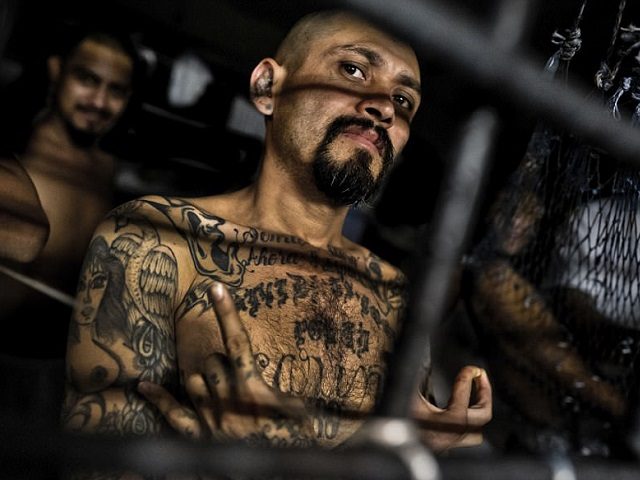Donald Trump has made many references to the violent Central American MS-13 gang. Its members are among those “bad hombres” he famously talked about in the October 2016 presidential debate when warning of the dangers of drug lords and their deadly cartels. And he did not hesitate to mention that unchecked illegal immigration allows even criminal illegal aliens to roam freely in the U.S.
So, with a president famous for embellishment, it’s fair to wonder if MS-13 is the real thing, or just a Trump boogeyman. Is it in fact a gang that’s been hyped beyond its true capability, worked as a clapper against the president’s bell of nationalist rhetoric and anti-immigration fear-mongering?
Trump got the public’s attention during his recent State of the Union address when he introduced four still-grieving parents painfully gripped by the murder of their daughters at MS-13 hands on Long Island. Nisa Mickens and Kayla Cuevas were teenagers, one of whom had a reported dispute with a local MS-13 faction in September 2016. When spotted on the street, four homicidal MS members unleashed a savage baseball bat and machete attack on the defenseless pair, killing them both.
The Feds indicted 13 gang members, ten of whom were in the U.S. illegally. How many of those were “Dreamers” and exactly what their dreams may have been is unclear, but the president’s SOTU words and visuals were powerful and poignant.
The brutality of the Long Island attack was no outlier. It’s estimated that MS-13 has as many as 10,000 members in at least 40 states. In Northern Virginia and Maryland, once thinning MS-13 ranks, diminished by successful federal prosecutions, have been reconstituted with unaccompanied minors sent to the U.S. by families and gang masters in Central America.
The gang’s calling card has been discovered across the region – shallow graves bearing the remains of youthful victims showing evidence of horrific deaths.
Just a few miles from the White House sits wealthy Fairfax County, Virginia. Less than two weeks before the new president’s inauguration, 17-year-old Venus Romero Iraheta participated in the abduction and murder of 15-year-old Damaris Alexandra Reyes Rivas in a Fairfax County park. In her confession to police, the killer admitted telling her victim, “You’re going to remember me until the day we see each other in hell. Don’t forget my name,” before stabbing her repeatedly in the neck, stomach, and chest and dumping her body in a puddle and covering it with railroad ties. Ten people have been charged in the case – including one who recorded the torture and murder on a cellphone video for further propaganda by the gang.
Such cases are the MS-13 norm. Youthful offenders with none of life’s guardrails, propped up by commands from Central American leaders to establish gang primacy in American communities, engage in aggressive recruitment while threatening violence against any who resist or oppose them. The emboldened gang then sets about fulfilling their motto: “kill, rape, control.”
When I was an FBI agent, supervisor, and executive, we recognized the particular value of accomplishments known as “D&Ds” – disruptions and dismantlements of criminal enterprises. Agents were encouraged to reach for this gold standard, using actions that either took a chunk out of or eliminated entirely gangs and gang factions. It was valued because each disruption set the gang back in some way, whether by an arrest, a drug or money seizure, or execution of an intrusive search warrant.
Cases could be many months in the making, as the FBI and its state and local partners used an array of electronic surveillance techniques to develop evidence to on large scale conspiracies and seal federal prosecutions.
But now, with the Trump administration willing to actually enforce immigration laws, Immigration and Customs Enforcement (ICE) can play a larger role by identifying and deporting illegal alien MS-13 members and recruits before the more complex investigative efforts are even necessary.
Attorney General Jeff Sessions recognizes the threat of MS-13 and has been directing federal law enforcement resources to meet it head on. At the International Association of Chiefs of Police conference in Philadelphia last fall he said of the Feds, “Now, they will go after MS-13 with a renewed vigor and a sharpened focus. I am announcing that I have authorized them to use every lawful tool to investigate MS-13 — and not just our drug laws, but everything from RICO racketeering to our tax laws to our firearms laws. Just like we took Al Capone off the streets with our tax laws, we will use whatever laws we have to get MS-13 off the streets.”
Sessions left out one tool that’s firmly in the Fed’s hands – immigration enforcement. Despite the protests from the left, the Trump administration should sharpen that rusting tool and then wear it out through its aggressive use.
Any notion that the federal government is powerless to prevent more grieving parents like those of Nisa Mickens and Kayla Cuevas should be put to rest as ICE fills its prisoner transport buses with MS-13 members bound for Central America. Unfortunately, they aren’t just Trump’s boogeymen. These monsters are real.
Ron Hosko is president of the Law Enforcement Action Network. He served 30 years in the FBI, most recently as assistant director of the Criminal Investigative Division.

COMMENTS
Please let us know if you're having issues with commenting.